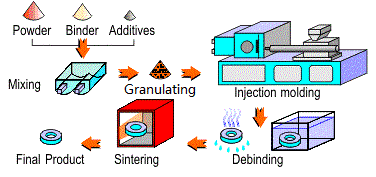Ceramic Injection Molding (CIM) is very suitable for high volume production of complex design with tight tolerances like bonding capillaries. It is an effective way of manufacturing complex precision components with the highest degree of repeatability and reproducibility.

Ceramic Injection Molding Process Flow:
1. Material Preparation
The characteristics of the ceramic powders, such as grain size distribution and morphology play a vital role not only in the achievement of the desired product properties, but also in the success of the different stages of the process. The ceramic powders used for the manufacturing of capillaries are selected by size and shape and complemented with additives to obtain the necessary chemical and physical properties.
2. Mixing and Granulating
Before the injection molding, the powder is mixed with binder to form a homogeneous mixture that is used to form the shape of the capillary. The binder is used for the artificial plasticisation of the ceramic powders and for the formation of the desired shape through injection molding. Consideration for binder selection includes the flow characteristics for injection molding, the ease of binder removal and binder-powder interaction.
3. Injection Molding
Subsequently, the mixture is feed to the mold for injection molding. The molding process is a significantly affected by the temperature, pressure and time envelope and it is essential to have the correct temperature and pressure sequence together with the time sequence.
4. Debinging
The binder is removed by evaporation and exothermic reaction, leaving only a small fraction behind. Removal of the binder is a critical step between the molding operation and the sintering process. The extent of the binder removal requires careful monitoring and control to retain the shape of the capillary.
5. Sintering
The formed part is then sintered in an oxidizing or reducing atmosphere, or in a high vacuum at temperature of up to 1800°C. During sintering, the parts become more dense and shrink. Depending on the raw material properties, shrinkage ranges from 15% to 25% of its molded dimensions. Repeatably attaining the required dimensional tolerances on the sintered parts requires that the green density of the part be uniform within each part and consistent from part to part, and that the shrinkage during sintering be repeatable and predictable.
